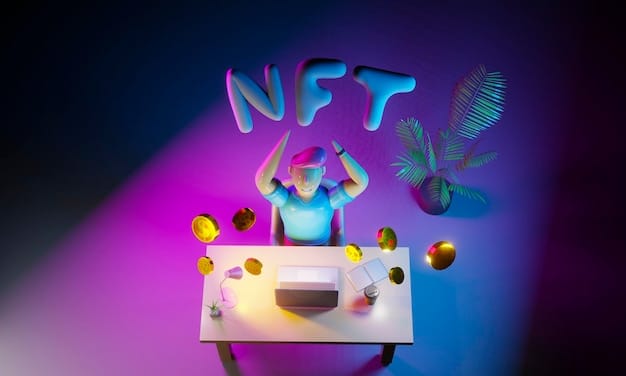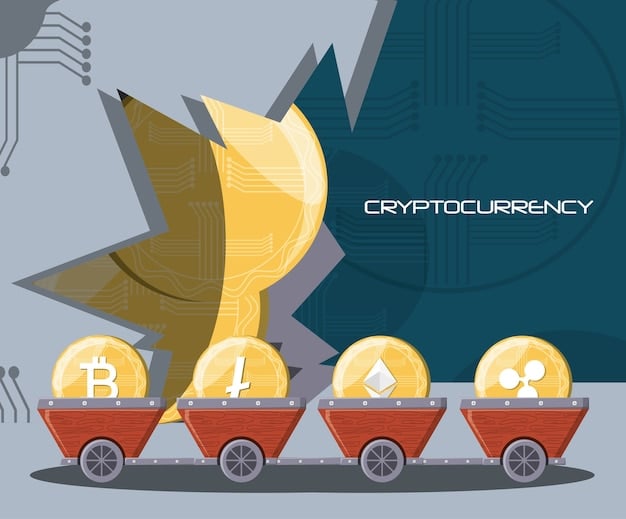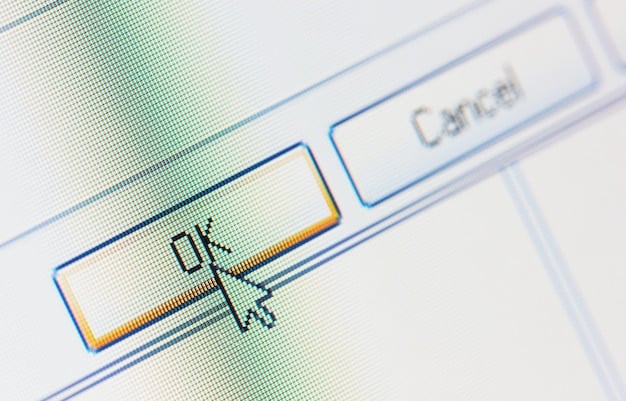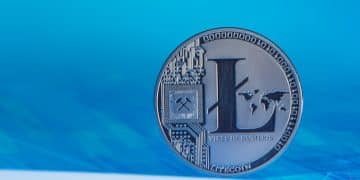NFT Minting on Solana: Launch Your Project Under $500

NFT minting on Solana is a cost-effective way to launch your project, often achievable with under $500 through efficient smart contracts, optimized storage solutions, and leveraging Solana’s lower transaction fees.
Interested in creating your own NFTs but worried about the high costs? NFT minting on Solana: A step-by-step guide to launching your project with under $500 in initial costs makes it an attractive option for creators. Solana’s blockchain offers faster transaction speeds and significantly lower fees compared to Ethereum, making it a viable platform for affordable NFT projects. This guide will walk you through the process, covering everything from setting up your wallet to deploying your smart contract and minting your first NFT, all while keeping your expenses minimal.
Understanding the Basics of NFT Minting on Solana
Before diving into the technical steps, let’s cover the fundamentals. Solana operates differently from Ethereum, which impacts how you mint and manage NFTs. Understanding these differences is crucial for a smooth and cost-effective minting process.
Solana vs. Ethereum: Key Differences for NFT Creators
One of the biggest differences lies in the consensus mechanism and transaction fees. Solana uses a Proof of History (PoH) combined with Proof of Stake (PoS) consensus, resulting in faster and cheaper transactions. This contrasts sharply with Ethereum’s higher gas fees, particularly during periods of network congestion.
- Transaction Fees: Solana’s transaction fees are typically a fraction of a cent, whereas Ethereum’s can range from a few dollars to hundreds during peak times.
- Transaction Speed: Solana boasts significantly faster transaction speeds, processing thousands of transactions per second (TPS) compared to Ethereum’s slower rate.
- Smart Contract Language: Solana uses Rust for smart contract development, while Ethereum primarily uses Solidity.
Choosing Solana can drastically reduce the upfront costs associated with deploying smart contracts and minting NFTs, especially for larger collections.

In summary, Solana provides a scalable and affordable environment for NFT creation, making it an excellent choice for projects with limited budgets.
Setting Up Your Solana Wallet and Acquiring SOL
The first step is to set up a Solana wallet. This wallet will hold the SOL tokens needed to pay for transaction fees and will also manage your NFTs. There are several wallet options available, each with its own features and security considerations.
Popular Solana Wallets
Several wallets support Solana, each offering different levels of security and convenience. Here are a few popular options:
- Phantom: A browser extension wallet known for its user-friendly interface and seamless integration with Solana dApps.
- Solflare: A web-based wallet that offers both browser extension and web interface options, providing flexibility for users.
- Sollet: A basic, open-source wallet that’s ideal for developers and users who prefer a more minimalist approach.
After choosing a wallet, you need to acquire SOL tokens. You can purchase SOL on major cryptocurrency exchanges like Binance, Coinbase, or Kraken. Once you have SOL, transfer it to your newly created Solana wallet.
Configuring your wallet and securing SOL tokens are crucial first steps, setting the stage for the remainder of the minting process.
Creating Your NFT Metadata
NFT metadata describes the NFT, including its name, description, image, and other attributes. This metadata is stored on a decentralized storage solution, ensuring the NFT’s properties are immutable and verifiable.
Structuring Your Metadata
NFT metadata typically follows the JSON (JavaScript Object Notation) format. This structure provides a standardized way to define the properties of your NFT.
- Name: The name of your NFT.
- Description: A detailed description of your NFT.
- Image: A link to the image file associated with your NFT (hosted on decentralized storage).
- Attributes: Any additional properties or traits that define your NFT.
Storing your metadata on decentralized storage solutions ensures immutability and accessibility. Services like Arweave and IPFS (InterPlanetary File System) are commonly used for this purpose.

Properly structuring and storing your NFT metadata is vital for ensuring the longevity and integrity of your digital assets.
Choosing a Minting Method: Candy Machine vs. Custom Smart Contract
When it comes to minting NFTs on Solana, you have a couple of options: using a tool like Candy Machine or deploying a custom smart contract. Each approach has its own advantages and disadvantages, particularly regarding cost and customization.
Using Candy Machine
Candy Machine is a popular tool developed by Metaplex, the standard for NFTs on Solana. It simplifies the minting process and provides a straightforward way to launch your NFT collection. Here’s what you need to know:
- Pros: Easy to set up, requires minimal coding, and offers built-in features like whitelisting and presales.
- Cons: Limited customization options, can be more expensive for large collections due to Metaplex fees, and requires familiarity with the Metaplex framework.
Deploying a Custom Smart Contract
Alternatively, you can create a custom smart contract to mint your NFTs. This approach provides maximum flexibility and control over the minting process. Here’s what you need to consider:
- Pros: Full control over functionality, lower fees for large collections, and ability to implement custom features.
- Cons: Requires coding knowledge (Rust), more complex setup, and responsibility for security and optimization.
For projects aiming for simplicity and quick deployment, Candy Machine is often the preferred choice. However, for those seeking greater control and cost-effectiveness with larger collections, a custom smart contract may be more suitable.
Selecting the right minting method is a crucial decision that can impact both the cost and functionality of your NFT project.
Minting Your NFT
With your wallet set up, metadata created, and minting method chosen, you’re ready to mint your NFT. The exact steps will vary depending on whether you’re using Candy Machine or a custom smart contract.
Minting with Candy Machine
If you’ve chosen Candy Machine, you’ll need to configure the Candy Machine CLI tool and upload your metadata. Then, you can use the CLI to mint your NFTs.
- Install Candy Machine CLI: Follow the Metaplex documentation to install the Candy Machine CLI tool.
- Configure Candy Machine: Set up the Candy Machine with your desired settings, including price, start date, and whitelisting options.
- Upload Metadata: Upload your NFT metadata to Arweave or IPFS.
- Mint NFTs: Use the Candy Machine CLI to mint your NFTs.
Minting with a Custom Smart Contract
If you’ve opted for a custom smart contract, you’ll need to deploy your contract to the Solana blockchain and then interact with it to mint your NFTs.
- Deploy Smart Contract: Deploy your smart contract to the Solana blockchain using the Solana CLI tool.
- Mint NFTs: Interact with your smart contract using the Solana CLI or a web-based interface to mint your NFTs.
Using a chosen method, minting NFTs involves uploading metadata, configuring CLI tools, and interacting with smart contracts in order to create your digital assets on the Solana blockchain.
Listing Your NFT on a Marketplace
Once your NFTs are minted, the next step is to list them on a marketplace where potential buyers can discover and purchase them. Several NFT marketplaces support Solana, each with its own user base and fee structure.
Popular Solana NFT Marketplaces
There are several options for listing your NFTs on Solana:
- Magic Eden: One of the most popular Solana NFT marketplaces, known for its high traffic and user-friendly interface.
- Solanart: Another leading Solana NFT marketplace with a wide variety of NFT collections.
- DigitalEyes: A community-driven marketplace with a focus on emerging artists and unique NFT projects.
When listing your NFTs, consider factors such as transaction fees, listing fees, and the marketplace’s overall reach and visibility.
Listing NFTs on marketplaces provides high visibility and an opportunity for creators to connect directly with buyers, enabling them to monetize their digital assets.
| Key Point | Brief Description |
|---|---|
| 💡 Solana’s Advantages | Lower fees and faster transactions compared to Ethereum. |
| 💰 Budgeting | Launch an NFT project with under $500 by optimizing choices. |
| 🧰 Minting Methods | Choose between Candy Machine for simplicity and Custom Smart Contracts for full flexibility. |
| 🛒 Marketplace Listing | List NFTs on Magic Eden, Solanart, or DigitalEyes. |
FAQ
▼
Solana offers faster transaction speeds and significantly lower transaction fees compared to Ethereum, making it a cost-effective choice for NFT projects, particularly for larger collections. This efficiency allows creators to offer NFTs at lower prices, potentially attracting a wider audience.
▼
The cost can vary, but typically, minting an NFT on Solana can be done for less than a dollar due to low gas fees. However, costs may increase depending on the complexity of the smart contract and the chosen minting method, either Candy Machine or Custom Smart Contracts.
▼
Candy Machine is a tool developed by Metaplex that simplifies the process of minting NFTs on Solana. It provides a user-friendly interface for setting up whitelists, presales, and other features with minimal coding, reducing the costs involved in technical development.
▼
Popular Solana wallets include Phantom, Solflare, and Sollet. Phantom is known for its user-friendly interface, while Solflare offers both browser extension and web-based options. Sollet, on the other hand, is a minimalist, open-source option suitable for developers.
▼
You can list your NFTs on Solana on popular marketplaces like Magic Eden, Solanart, and DigitalEyes. Each marketplace has its own user base and fee structure, so consider factors such as transaction fees, listing fees, and overall reach before listing your NFTs.
Conclusion
Minting NFTs on Solana offers a compelling alternative to Ethereum, providing lower fees and faster transactions. By following this step-by-step guide and carefully considering your options, you can launch your NFT project for under $500, making it accessible to a wider range of creators and enthusiasts.





